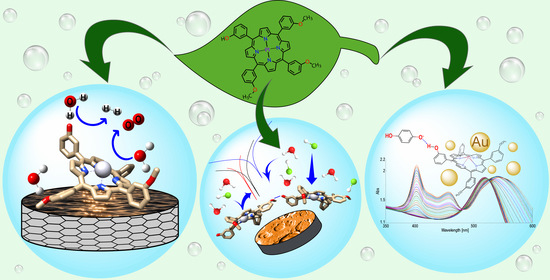One A3B Porphyrin Structure—Three Successful Applications
Abstract
:1. Introduction
2. Materials and Methods
2.1. Materials
2.2. Apparatus
2.3. Working Electrodes Preparation
2.4. Electrochemical Experiments to Evaluate the Electrocatalytic Properties for the HER and OER of the Porphyrin-Modified Electrodes
2.5. Method for Obtaining A3B Porphyrin Derivatives
2.5.1. Method for Obtaining 5-(3-Hydroxy-phenyl)-10,15,20-tris-(3-methoxy-phenyl)-porphyrin (OH-3MeOPP)
2.5.2. Method for Obtaining Pt(II)-5-(3-Hydroxy-phenyl)-10,15,20-tris-(3-methoxy- phenyl)-porphyrin (Pt-OH-3MeOPP)
3. Results and Discussions
3.1. Spectroscopic Characterisation
3.1.1. Comparison of OH-3MeOPP and Pt-OH-3MeOPP NMR Spectra
3.1.2. Discussion Regarding UV-Vis Spectra of OH-3MeOPP and Pt-OH-3MeOPP
- Effect of protonation Protonation on UV-Vis spectra Spectra of OH-3MeOPP
3.1.3. Comparative Aspects of OH-3MeOPP and Pt-OH-3MeOPP FT-IR Spectra
3.2. Combined Microscopic Investigations
3.3. Generation of the Pt-OH-3MeOPP-AuNPs Complex
3.3.1. AuNPs Colloid Preparation
3.3.2. Method for Obtaining the Pt-OH-3MeOPP-AuNPs Complex
3.4. Detection of HQ Use as Sensitive Material A3B Porphyrin Derivatives
3.4.1. UV-Vis Detection of HQ by Acidulated Pt-OH-3MeOPP-AuNPs Complex
- Interfering species study for the UV-Vis detection of HQ
- Detection mechanism
3.4.2. Fluorescence Detection of HQ by OH-3MeOPP in Acid Medium
3.5. Corrosion Tests
3.5.1. Thin Films Realisation
3.5.2. Electrochemical Measurements
3.5.3. AFM Investigation of Covered Steel Electrodes with Two Porphyrin Derivatives
3.6. Main Results Regarding the OER and HER Electrocatalytic Activity of the Two Investigated Porphyrin Derivatives, Obtained in Strong Alkaline and Acidic Electrolyte Solutions
3.6.1. Polarisation Curves in Alkaline Medium
3.6.2. Polarisation Curves in Acidic Medium
3.6.3. Further Electrochemical Investigations on the GP2-DMF Electrode
- Electrochemical Study of HER Kinetics
- Considerations regarding HER catalytic behaviour
4. Conclusions
Supplementary Materials
Author Contributions
Funding
Institutional Review Board Statement
Informed Consent Statement
Data Availability Statement
Acknowledgments
Conflicts of Interest
References
- Caroleo, F.; Magna, G.; Damiano, C.; Cavalleri, M.; Gallo, E.; Di Natale, C.; Paolesse, R. Colour Catcher® sheet beyond the laundry: A low-cost support for realizing porphyrin-based mercury ion sensors. Sens. Actuators B Chem. 2022, 364, 131900. [Google Scholar] [CrossRef]
- Kari, N.; Zannotti, M.; Giovannetti, R.; Reha, D.; Minofar, B.; Abliz, S.; Yimit, A. Metallic Effects on p-Hydroxyphenyl Porphyrin Thin-Film-Based Planar Optical Waveguide Gas Sensor: Experimental and Computational Studies. Nanomaterials 2022, 13, 944. [Google Scholar] [CrossRef]
- Ma, Q.; Ran, B.; Wu, J.; Wei, Z.; Wang, H. A novel fluorescent “on-off-on” sensor for monohydrogen phosphate based on the 5, 10, 15, 20-(4-sulphonatophenyl) porphyrin (TSPP) in nutrient solution and DFT calculation. J. Porphyr. Phthalocyanines 2022, 26, 232–241. [Google Scholar] [CrossRef]
- Ren, H.; Liu, C.; Jiang, J. Sensitive and selective sensor based on porphyrin porous organic cage fluorescence towards copper ion. Dyes Pigments 2022, 200, 110117. [Google Scholar] [CrossRef]
- Dar, T.A.; Sankar, M. Fused Nickel (II) Porphyrins—Sensing of Toxic Anions and Selected Metal Ions Through Supramolecular Interactions. Front. Chem. 2020, 8, 595177. [Google Scholar] [CrossRef]
- Lvova, L.; Monti, D.; Di Natale, C.; Paolesse, R. The Long-Lasting Story of One Sensor Development: From Novel Ionophore Design toward the Sensor Selectivity Modeling and Lifetime Improvement. Sensors 2021, 21, 1401. [Google Scholar] [CrossRef] [PubMed]
- Klyamer, D.; Shutilov, R.; Basova, T. Recent Advances in Phthalocyanine and Porphyrin-Based Materials as Active Layers for Nitric Oxide Chemical Sensors. Sensors 2021, 22, 895. [Google Scholar] [CrossRef]
- Jiang, J.; Cai, Q.; Deng, M. Construction of Electrochemical Aptamer Sensor Based on Pt-Coordinated Titanium-Based Porphyrin MOF for Thrombin Detection. Front. Chem. 2022, 9, 812983. [Google Scholar] [CrossRef] [PubMed]
- Lokesh, K.S.; De Keersmaecker, M.; Elia, A.; Depla, D.; Dubruel, P.; Vandenabeele, P.; Van Vlierberghe, S.; Adriaens, A. Adsorption of cobalt (II) 5,10,15,20-tetrakis(2-aminophenyl)-porphyrin onto copper substrates: Characterization and impedance studies for corrosion inhibition. Corros. Sci. 2012, 62, 73–82. [Google Scholar] [CrossRef] [Green Version]
- Birdeanu, A.V.; Birdeanu, M.; Fagadar-Cosma, E. Corrosion protection characteristics of ceramics, porphyrins and hybrid ceramics/porphyrins, deposited as single and sandwich layers, by pulsed laser deposition (PLD). J. Alloys Compd. 2017, 706, 220–226. [Google Scholar] [CrossRef]
- Wang, J.; Lin, Y.; Singh, A.; Liu, W. Investigation of some Porphyrin Derivatives as Inhibitors for Corrosion of N80 Steel at High Temperature and High Pressure in 3.5% NaCl solution containing carbon dioxide. Int. J. Electrochem. Sci. 2018, 13, 11961–11973. [Google Scholar] [CrossRef]
- Deyab, M.A.; Mohsen, Q. Controlling the corrosion and hydrogen gas liberation inside lead-acid battery via PANI/Cu-Pp/CNTs nanocomposite coating. Sci. Rep. 2021, 11, 9507. [Google Scholar] [CrossRef]
- Munawaroh, H.; Sunarya, Y.; Anwar, B.; Priatna, E.; Risa, H.; Koyande, A.K.; Show, P.-L. Protoporphyrin Extracted from Biomass Waste as Sustainable Corrosion Inhibitors of T22 Carbon Steel in Acidic Environments. Sustainability 2022, 14, 3622. [Google Scholar] [CrossRef]
- Bauer, C.; Treyer, K.; Antonini, C.; Bergerson, J.; Gazzani, M.; Gencer, E.; Gibbins, J.; Mazzotti, M.; McCoy, S.T.; McKenna, R.; et al. On the climate impacts of blue hydrogen production. Sustain. Energy Fuels 2022, 6, 66–75. [Google Scholar] [CrossRef]
- Cheng, W.; Lee, S. How Green Are the National Hydrogen Strategies? Sustainability 2022, 14, 1930. [Google Scholar] [CrossRef]
- Lee, J.E.; Jeon, K.-J.; Show, P.L.; Lee, I.H.; Jung, S.-C.; Choi, Y.J.; Rhee, G.H.; Lin, K.-Y.A.; Park, Y.-K. Mini review on H2 production from electrochemical water splitting according to special nanostructured morphology of electrocatalysts. Fuel 2022, 308, 122048. [Google Scholar] [CrossRef]
- Grimm, A.; Sainte-Marie, A.; Kramer, G.J.; Gazzani, M. Modeling photovoltaic-electrochemical water splitting devices for the production of hydrogen under real working conditions. Int. J. Hydrogen Energy 2022, 47, 11764–11777. [Google Scholar] [CrossRef]
- Cardenas-Morocoso, D.; Vey, E.; Heiderscheid, M.; Frache, G.; Boscher, N.D. Electronic and energy level engineering of directly fused porphyrin-conjugated polymers—Impact of the central metal cation. J. Mater. Chem. C 2022, 10, 2194–2204. [Google Scholar] [CrossRef]
- Duan, S.; Uragami, C.; Horiuchi, K.; Hino, K.; Wang, X.F.; Sasaki, S.; Tamiaki, H.; Hashimoto, H. Hydroquinone redox mediator enhances the photovoltaic performances of chlorophyll-based bio-inspired solar cells. Commun. Chem. 2021, 4, 118. [Google Scholar] [CrossRef]
- Xu, H.; Guo, M.Y.; Gao, Y.H.; Bai, X.H.; Zhou, X.W. Expression and characteristics of manganese peroxidase from Ganodermalucidum in Pichia pastoris and its application in the degradation of four dyes and phenol. BMC Biotechnol. 2017, 17, 19. [Google Scholar] [CrossRef] [Green Version]
- Jaiswal, S.; Gupta, G.K.; Panchal, K.; Mandeep, D.; Shukla, P. Synthetic Organic Compounds From Paper Industry Wastes: Integrated Biotechnological Interventions. Front. Bioeng. Biotechnol. 2021, 8, 592939. [Google Scholar] [CrossRef] [PubMed]
- Stenius, U.; Warholm, M.; Rannug, A.; Walles, S.; Lundberg, I.; Högberg, J. The role of GSH depletion and toxicity in hydroquinone-induced development of enzyme-altered foci. Carcinogenesis 1989, 10, 593–599. [Google Scholar] [CrossRef] [PubMed]
- Sabari Arul, N.; Mangalaraj, D.; Han, J.I.; Cavalcante, L.S. Structure and electrochemical detection of xenobiotic micro-pollutant hydroquinone using CeO2 nanocrystals. RSC Adv. 2015, 5, 70558–70565. [Google Scholar] [CrossRef]
- Monteiro, R.C.; Kishore, B.N.; Bhat, R.M.; Sukumar, D.; Martis, J.; Ganesh, H.K. A Comparative Study of the Efficacy of 4% Hydroquinone vs 0.75% Kojic Acid Cream in the Treatment of Facial Melasma. Indian J. Dermatol. 2013, 58, 157. [Google Scholar] [CrossRef]
- Tse, T.W. Hydroquinone for skin lightening: Safety profile, duration of use and when should we stop? J. Dermatol. Treat. 2010, 21, 272–275. [Google Scholar] [CrossRef]
- O’Donoghue, J.L. Hydroquinone and its analogues in dermatology—A risk–benefit viewpoint. J. Cosmet. Dermatol. 2006, 5, 196–203. [Google Scholar] [CrossRef]
- Cabrera-Alonso, R.; Guevara, E.; Ramírez-Elías, M.G.; Moncada, B.; González, F.J. Detection of hydroquinone by Raman spectroscopy in patients with melasma before and after treatment. Skin Res. Technol. 2018, 25, 20–24. [Google Scholar] [CrossRef]
- Lin, C.H.; Sheu, J.Y.; Wu, H.L.; Huang, Y.L. Determination of hydroquinone in cosmetic emulsion using microdialysis sampling coupled with high-performance liquid chromatography. J. Pharm. Biomed. Anal. 2005, 38, 414–419. [Google Scholar] [CrossRef] [PubMed]
- She, Y.; Tang, Y.; Liu, H.; He, P. Electrochemical determination of hydroquinone using hydrophobic ionic liquid-type carbon paste electrodes. Chem. Cent. J. 2010, 4, 17. [Google Scholar] [CrossRef] [Green Version]
- Hu, Y.; Xue, Z.; He, H.; Ai, R.; Liu, X.; Lu, X. Photoelectrochemical sensing for hydroquinone based on porphyrin-functionalized Au nanoparticles on graphene. Biosens. Bioelectron. 2013, 47, 45–49. [Google Scholar] [CrossRef]
- D’Souza, F.; Deviprasad, G.R. Studies on Porphyrin−Quinhydrone Complexes: Molecular Recognition of Quinone and Hydroquinone in Solution. J. Org. Chem. 2001, 66, 4601–4609. [Google Scholar] [CrossRef]
- Yang, S.; Wu, S.; Liu, J.; Fa, H.; Yang, M.; Hou, C. Simultaneous Electrochemical Detection of Co-Existing Dihydroxybenzene Isomers Using Porphyrin Zr Metal-Organic Frameworks/β-cyclodextrin/Pencil Graphite Electrode. IEEE Sens. J. 2022, 22, 2993–3000. [Google Scholar] [CrossRef]
- Ma, B.; Guo, H.; Wang, M.; Wang, Q.; Yang, W.; Wang, Y.; Yang, W. Electrocatalysis and simultaneous determination of hydroquinone and acetaminophen using PN-COF/graphene oxide modified electrode. Microchem. J. 2020, 155, 104776. [Google Scholar] [CrossRef]
- Grafov, O.Y.; Kazansky, L.P. Review on porphyrins, phthalocyanines and their derivatives as corrosion inhibitors. Int. J. Corros. Scale Inhib. 2020, 9, 812–829. [Google Scholar] [CrossRef]
- Birdeanu, M.; Fratilescu, I.; Epuran, C.; Murariu, A.C.; Socol, G.; Fagadar-Cosma, E. Efficient Decrease in Corrosion of Steel in 0.1 M HCl Medium Realized by a Coating with Thin Layers of MnTa2O6 and Porphyrins Using Suitable Laser-Type Approaches. Nanomaterials 2022, 12, 1118. [Google Scholar] [CrossRef]
- Birdeanu, M.; Epuran, C.; Fratilescu, I.; Fagadar-Cosma, E. Structured Thin Films Based on Synergistic Effects of MnTa2O6 Oxide and bis-Carboxy-phenyl-substituted Porphyrins, Capable to Inhibit Steel Corrosion. Processes 2021, 9, 1890. [Google Scholar] [CrossRef]
- Deyab, M.A.; Mele, G.; Al-Sabagh, A.M.; Bloise, E.; Lomonaco, D.; Mazzetto, S.E.; Clemente, C.D.S. Synthesis and characteristics of alkyd resin/M-Porphyrins nanocomposite for corrosion protection application. Prog. Org. Coat. 2017, 105, 286–290. [Google Scholar] [CrossRef]
- García-Pérez, C.A.; Menchaca-Campos, C.; García-Sánchez, M.A.; Uruchurtu, J. Electrochemical Capacitive Properties of Ny/PP/GO Electro-spun Composite Coating on Stainless Steel in Acid Media. Eur. J. Eng. Technol. Res. 2022, 7, 81–86. [Google Scholar] [CrossRef]
- Deyab, M.A.; Mele, G. Stainless steel bipolar plate coated with polyaniline/Zn-Porphyrin composites coatings for proton exchange membrane fuel cell. Sci. Rep. 2020, 10, 3277. [Google Scholar] [CrossRef]
- Singh, A.; Talha, M.; Xu, X.; Sun, Z.; Lin, Y. Heterocyclic Corrosion Inhibitors for J55 Steel in a Sweet Corrosive Medium. ACS Omega 2017, 2, 8177–8186. [Google Scholar] [CrossRef] [Green Version]
- Barber, J. Solar-driven water-splitting provides a solution to the energy problem underpinning climate change. Biochem. Soc. Trans. 2020, 48, 2865–2874. [Google Scholar] [CrossRef]
- Yu, F.; Zhou, H.; Huang, Y.; Sun, J.; Qin, F.; Bao, J.; Goddard, W.A.; Chen, S.; Ren, Z. High-performance bifunctional porous non-noble metal phosphide catalyst for overall water splitting. Nat. Commun. 2018, 9, 2551. [Google Scholar] [CrossRef] [Green Version]
- Hu, E.; Feng, Y.; Nai, J.; Zhao, D.; Hu, Y.; Lou, X.W. Construction of hierarchical Ni–Co–P hollow nanobricks with oriented nanosheets for efficient overall water splitting. Energy Environ. Sci. 2018, 11, 872–880. [Google Scholar] [CrossRef]
- Li, X.; Zhao, L.; Yu, J.; Liu, X.; Zhang, X.; Liu, H.; Zhou, W. Water splitting: From electrode to green energy system. Nano-Micro Lett. 2020, 12, 131. [Google Scholar] [CrossRef]
- Chen, Z.; Wei, W.; Chen, H.; Ni, B.-J. Eco-designed electrocatalysts for water splitting: A path toward carbon neutrality. Int. J. Hydrogen Energy 2022, 48, 2865–2874. [Google Scholar] [CrossRef]
- Rashid, M.; Mesfer, M.K.A.; Naseem, H.; Danish, M. Hydrogen Production by Water Electrolysis: A review of alkaline water electrolysis, PEM water electrolysis and high temperature water electrolysis. Int. J. Ang. Adv. Res. Technol. 2015, 4, 80–93. [Google Scholar]
- Wang, S.; Lu, A.; Zhong, C.-J. Hydrogen production from water electrolysis: Role of catalysts. Nano Converg. 2021, 8, 4. [Google Scholar] [CrossRef]
- Yan, Y.; Xia, B.Y.; Zhao, B.; Wang, X. A review on noble-metal-free bifunctional heterogeneous catalysts for overall electrochemical water splitting. J. Mater. Chem. A 2016, 4, 17587–17603. [Google Scholar] [CrossRef] [Green Version]
- Taranu, B.O.; Fagadar-Cosma, E. Catalytic Properties of Free-Base Porphyrin Modified Graphite Electrodes for Electrochemical Water Splitting in Alkaline Medium. Processes 2022, 10, 611. [Google Scholar] [CrossRef]
- Haddad, R.E.; Gazeau, S.; Pécaut, J.; Marchon, J.-C.; Medforth, C.J.; Shelnutt, J.A. Origin of the Red Shifts in the Optical Absorption Bands of Nonplanar Tetraalkylporphyrins. J. Am. Chem. Soc. 2003, 125, 1253–1268. [Google Scholar] [CrossRef]
- Senge, M.O.; Ema, T.; Smith, K.M. Crystal structure of a remarkably rouffled nonplanar porphyrin (pyridine) [5,10,15,20-tetra(tert-butyl)porphyrinato]zinc(II). J. Chem. Soc. Chem. Commun. 1995, 7, 733. [Google Scholar] [CrossRef] [Green Version]
- Hanna, L.; Movsesian, E.; Orozco, M.; Bernot, A.R., Jr.; Asadinamin, M.; Shenje, L.; Ullrich, S.; Zhao, Y.; Marshall, N.; Weeks, J.A.; et al. Spectroscopic investigation of the electronic and excited state properties of para-substituted tetraphenyl porphyrins and their electrochemically generated ions. Spectrochim. Acta A Mol. Biomol. Spectrosc. 2022, 278, 121300. [Google Scholar] [CrossRef] [PubMed]
- Schulz, S.; Ziganshyna, S.; Lippmann, N.; Glass, S.; Eulenburg, V.; Habermann, N.; Schwarz, U.T.; Voigt, A.; Heilmann, C.; Rüffer, T.; et al. The Meta-Substituted Isomer of TMPyP Enables More Effective Photodynamic Bacterial Inactivation than Para-TMPyP In Vitro. Microorganisms 2022, 10, 858. [Google Scholar] [CrossRef]
- Conradie, J.; Ghosh, A. Energetics of Saddling versus Ruffling in Metalloporphyrins: Unusual Ruffled Dodecasubstituted Porphyrins. ACS Omega 2017, 2, 6708–6714. [Google Scholar] [CrossRef]
- Birdeanu, M.; Fagadar-Cosma, E. The self-assembly of porphyrin derivatives into 2D and 3D architectures. In Quantum Nanosystems: Structure, Properties, and Interactions; Putz, M.V., Ed.; Apple Academic Press: Toronto, ON, Canada; CRC Press: Boca Raton, FL, USA, 2015; ISBN 9781774633144. [Google Scholar]
- Taranu, B.O. Contribuții la caracterizarea fizico-chimică a porfirinelor. Aplicații în senzoristică și coroziune. Ph.D. Thesis, Institute of Chemistry Timisoara of Romanian Academy, Timisoara, Romania, 19 November 2016. [Google Scholar]
- Ahmad, Z. Principles of Corrosion Engineering and Corrosion Control, 1st ed.; IChemE Series; Butterworth-Heinemann: Oxford, UK, 2006; p. 377. [Google Scholar]
- Snyder, L.R.; Kirkland, J.J.; Glajch, J.L. Practical HPLC Method Development, 2nd ed.; John Wiley & Sons, Inc.: Hoboken, NJ, USA, 1997; pp. 722–723. ISBN 978-0-471-00703-6. [Google Scholar]
- Duan, Z.; Liu, H.; Tan, X.; Umar, A.; Wu, X. Bifunctional CoP electrocatalysts for overall water splitting. Catal. Commun. 2022, 162, 106379. [Google Scholar] [CrossRef]
- Liu, P.F.; Yang, S.; Zhang, B.; Yang, H.G. Defect-rich ultrathin cobalt-iron layered double hydroxide for electrochemical overall water splitting. ACS Appl. Mater. Interfaces 2016, 8, 34474–34481. [Google Scholar] [CrossRef]
- Zhao, Z.; Wu, H.; He, H.; Xu, X.; Jin, Y. Self-standing non-noble metal (Ni–Fe) oxide nanotube array anode catalysts with synergistic reactivity for high-performance water oxidation. J. Mater. Chem. A 2015, 3, 7179–7186. [Google Scholar] [CrossRef]
- Motoc, S.; Manea, F.; Orha, C.; Pop, A. Enhanced electrochemical response of diclofenac at a fullerene–carbon nanofiber paste electrode. Sensors 2019, 19, 1332. [Google Scholar] [CrossRef] [Green Version]
- Yang, M.; Yang, Y.; Liu, Y.; Shen, G.; Yu, R. Platinum nanoparticles-doped sol-gel/carbon nanotubes composite electrochemical sensors and biosensors. Biosens. Bioelectron. 2006, 21, 1125–1131. [Google Scholar] [CrossRef]
- Fringu, I.; Lascu, A.; Macsim, A.M.; Fratilescu, I.; Epuran, C.; Birdeanu, M.; Fagadar-Cosma, E. Pt(II)-A2B2 metalloporphyrin-AuNPS hybrid material suitable for optical detection of 1-anthraquinonsulfonic acid. Chem. Pap. 2022, 76, 2513–2527. [Google Scholar] [CrossRef]
- Hensley, A.; Schneider, S.; Wang, Y.; McEwen, J.-S. Adsorption of Aromatics on the (111) Surface of PtM and PtM3 (M = Fe, Ni) Alloys. RSC Adv. 2015, 104, 85705–85719. [Google Scholar] [CrossRef]
- Muthukumar, P.; Abraham John, S. Gold nanoparticles decorated on cobalt porphyrin-modified glassy carbon electrode for the sensitive determination of nitrite ion. J. Colloid Interface Sci. 2014, 421, 78–84. [Google Scholar] [CrossRef] [PubMed]
- Epuran, C.; Fratilescu, I.; Macsim, A.M.; Lascu, A.; Ianasi, C.; Birdeanu, M.; Fagadar-Cosma, E. Excellent cooperation between carboxyl-substituted porphyrins, k-carrageenan and AuNPs for extended application in CO2 capture and manganese ion detection. Chemosensors 2022, 10, 133. [Google Scholar] [CrossRef]
- Topping, D.C.; Bernard, L.G.; O’Donoghue, J.L.; English, J.C. Hydroquinone: Acute and subchronic toxicity studies with emphasis on neurobehavioral and nephrotoxic effects. Food Chem Toxicol. 2007, 45, 70–78. [Google Scholar] [CrossRef]
- DeCaprio, A.P. The Toxicology of Hydroquinone—Relevance to Occupational and Environmental Exposure. Crit. Rev. Toxicol. 1999, 29, 283–330. [Google Scholar] [CrossRef]
- Desmoni, E.; Brunetti, B. About Estimating the Limit of Detection by the Signal to Noise Approach. Pharm. Anal. Acta 2015, 6, 1000355. [Google Scholar] [CrossRef]
- Fagadar-Cosma, E.; Lascu, A.; Shova, S.; Zaltariov, M.F.; Birdeanu, M.; Croitor, L.; Balan, A.; Anghel, D.; Stamatin, S. X-ray Structure Elucidation of a Pt-Metalloporphyrin and Its Application for Obtaining Sensitive AuNPs-Plasmonic Hybrids Capable of Detecting Triiodide Anions. Int. J. Mol. Sci. 2019, 20, 710. [Google Scholar] [CrossRef] [Green Version]
- Eyer, P. Effects of superoxide dismutase on the autoxidation of 1,4-hydroquinone. Chem. Biol. Interact. 1991, 80, 159–176. [Google Scholar] [CrossRef]
- Song, Y.; Wagner, B.A.; Lehmler, H.J.; Buettner, G.R. Semiquinone radicals from oxygenated polychlorinated biphenyls: Electron paramagnetic resonance studies. Chem Res. Toxicol. 2008, 21, 1359–1367. [Google Scholar] [CrossRef] [Green Version]
- Ge, J.; Isgor, O.B. Effects of Tafel slope, exchange current density and electrode potential on the corrosion of steel in concrete. Mater. Corros. 2007, 58, 573–582. [Google Scholar] [CrossRef]
- Lee, J.H.; Lee, S.J. Microscopic crystalline rods from the self-assembly of mixed porphyrin building blocks. Inorg. Chem. Commun. 2011, 14, 1014–1017. [Google Scholar] [CrossRef]
- Guo, Y.; Gan, L.; Shang, C.; Wang, E.; Wang, J. A cake-style CoS2@MoS2/RGO hybrid catalyst for efficient hydrogen evolution. Adv. Funct. Mater. 2017, 27, 1602699. [Google Scholar] [CrossRef]
- Li, W.; Xiong, D.; Gao, X.; Liu, L. The oxygen evolution reaction enabled by transition metal phosphide and chalcogenide pre-catalysts with dynamic changes. Chem. Commun. 2019, 55, 8744–8763. [Google Scholar] [CrossRef]
- Menezes, P.W.; Panda, C.; Loos, S.; Bunschei-Bruns, F.; Walter, C.; Schwarze, M.; Deng, X.; Dau, H.; Driess, M. A structurally versatile nickel phosphite acting as a robust bifunctional electrocatalyst for overall water splitting. Energy Environ. Sci. 2018, 11, 1287–1298. [Google Scholar] [CrossRef] [Green Version]
- Liu, S.; Liu, P. Optimized Pt-Based Catalysts for Oxygen Reduction Reaction in Alkaline Solution: A First Principle Study. J. Electrochem. Soc. 2018, 165, J3090–J3094. [Google Scholar] [CrossRef]
- Taranu, B.O.; Sebarchievici, I.; Taranu, I.; Birdeanu, M.; Fagadar-Cosma, E. Electrochemical and microscopic characterization of two meso-substituted A3B and A4 porphyrins. Rev. Chim. Buchar. 2016, 67, 892–896. [Google Scholar]
- Bao, F.; Kemppainen, E.; Dorbandt, I.; Bors, R.; Xi, F.; Schlatmann, R.; van de Krol, R.; Calnan, S. Understanding the Hydrogen Evolution Reaction Kinetics of Electrodeposited Nickel-Molybdenum in Acidic, Near-Neutral, and Alkaline Conditions. ChemElectroChem 2021, 8, 195–208. [Google Scholar] [CrossRef]
- Sebarchievici, I.; Taranu, B.O.; Birdeanu, M.; Rus, S.F.; Fagadar-Cosma, E. Electrocatalytic behaviour and application of manganese porphyrin/gold nanoparticle-surface modified glassy carbon electrodes. Appl. Surf. Sci. 2016, 39, 131–140. [Google Scholar] [CrossRef]
- Ndlovu, T.; Arotiba, O.A.; Sampath, S.; Krause, R.W.; Mamba, B.B. Reactivities of modified and unmodified exfoliated graphite electrodes in selected redox systems. Int. J. Electrochem. Sci. 2012, 7, 9441–9453. [Google Scholar]
- Liu, C.Y.; Liu, Z.Y.; Peng, R.; Zhong, Z.C. Quasireversible Process of Dopamine on Copper-Nickel Hydroxide Composite/Nitrogen Doped Graphene/Nafion Modified GCE and Its Electrochemical Application. J. Anal. Methods Chem. 2014, 2014, 724538. [Google Scholar] [CrossRef] [Green Version]
- Shinagawa, T.; Garcia-Esparza, A.T.; Takanabe, K. Insight on Tafel slopes from a microkinetic analysis of aqueous electrocatalysis for energy conversion. Sci. Rep. 2015, 5, 13801. [Google Scholar] [CrossRef] [Green Version]
- Morales-Guio, C.G.; Stern, L.-A.; Hu, X. Nanostructured hydrotreating catalysts for electrochemical hydrogen evolution. Chem. Soc. Rev. 2014, 43, 6555–6569. [Google Scholar] [CrossRef] [Green Version]
- Zhang, W.; Lai, W.; Cao, R. Energy-related small molecule activation reactions: Oxygen reduction and hydrogen and oxygen evolution reactions catalyzed by porphyrin- and corrole-based systems. Chem. Rev. 2017, 117, 3717–3797. [Google Scholar] [CrossRef] [PubMed]
- Sobolewski, A.L.; Domcke, W. Photoinduced water splitting with oxotitanium porphyrin: A computational study. Phys. Chem. Chem. Phys. 2012, 14, 12807–12817. [Google Scholar] [CrossRef]
- Chou, P.; Kim, L.; Marzouk, S.M.; Sun, R.; Hartnett, A.C.; Dogutan, D.K.; Zheng, S.-L.; Nocera, D.G. Synthesis, Characterization, and Hydrogen Evolution Activity of Metallo-meso-(4-fluoro-2,6-dimethylphenyl)porphyrin Derivatives. ACS Omega 2022, 7, 8988–8994. [Google Scholar] [CrossRef] [PubMed]
- Beyene, B.B.; Hung, C.-H. Recent progress on metalloporphyrin-based hydrogen evolution catalysis. Coord. Chem. Rev. 2020, 410, 213234. [Google Scholar] [CrossRef]
- Seo, S.; Lee, K.; Min, M.; Cho, Y.; Kim, M.; Lee, H. A molecular approach to an electrocatalytic hydrogen evolution reaction on single-layer graphene. Nanoscale 2017, 9, 3969–3979. [Google Scholar] [CrossRef]
- Wang, H.; Lee, H.-W.; Deng, Y.; Lu, Z.; Hsu, P.C.; Liu, Y.; Lin, D.; Cui, Y. Bifunctional non-noble metal oxide nanoparticle electrocatalysts through lithium-induced conversion for overall water splitting. Nat. Commun. 2015, 6, 7261. [Google Scholar] [CrossRef] [Green Version]
- Li, Y.; Wang, H.; Xie, L.; Liang, Y.; Hong, G.; Dai, H. MoS2 Nanoparticles grown on graphene: An advanced catalyst for the hydrogen evolution reaction. J. Am. Chem. Soc. 2011, 133, 7296–7299. [Google Scholar] [CrossRef] [Green Version]
- Fang, Y.-H.; Liu, Z.-P. Tafel Kinetics of Electrocatalytic Reactions: From Experiment to First-Principles. ACS Catal. 2014, 4, 4364–4376. [Google Scholar] [CrossRef]
- Hamad, S.; Hernandez, N.C.; Aziz, A.; Ruiz-Salvador, A.R.; Calero, S.; Grau-Crespo, R. Electronic structure of porphyrin-based metal-organic frameworks and their suitability for solar fuel production photocatalysis. J. Mater. Chem. A 2015, 3, 23458–23465. [Google Scholar] [CrossRef] [Green Version]
- Scremin, J.; dos Santos, I.V.J.; Hughes, J.P.; Ferrari, A.G.-M.; Valderrama, E.; Zheng, W.; Zhong, X.; Zhao, X.; Sartori, E.J.R.; Crapnell, R.D.; et al. Platinum nanoparticle decorated vertically aligned graphene screen-printed electrodes: Electrochemical characterisation and exploration towards the hydrogen evolution reaction. Nanoscale 2020, 12, 18214–18224. [Google Scholar] [CrossRef]
- Wang, X.; Zhao, P.; Zhang, L.; Wang, Y.; Fu, Q.; Li, R.; Li, J.; Li, C.; Xie, C.; Fei, J. Switched electrochemical sensor for hydroquinone based on rGO@Au, monoclinic BiVO4 and temperature-sensitive polymer composite material. Microchem. J. 2022, 179, 107412. [Google Scholar] [CrossRef]
- Zhu, X.; Wang, M.; Xu, C.; Shi, S. Simultaneous Detection of Catechol and Hydroquinone Using Acetylene Black and Gold Nanoparticle Composite Modified Electrodes. ChemistrySelect 2022, 7, e202103384. [Google Scholar] [CrossRef]
- Raymundo-Pereira, P.A.; Gomes, N.O.; Machado, S.A.S.; Oliveira, O.N., Jr. Simultaneous, ultrasensitive detection of hydroquinone, paracetamol and estradiol for quality control of tap water with a simple electrochemical method. J. Electroanal. Chem. 2019, 848, 113319. [Google Scholar] [CrossRef]
- Cotchim, S.; Promsuwan, K.; Dueramae, M.; Duerama, S.; Dueraning, A.; Thavarungkul, P.; Kanatharana, P.; Lmbut, W. Development and Application of an Electrochemical Sensor for Hydroquinone in Pharmaceutical Products. J. Electrochem. Soc. 2020, 167, 155528. [Google Scholar] [CrossRef]
- Chetankumar, K.; Kumara Swamy, B.E.; Sharma, S.C.; Hariprasad, S.A. An efficient electrochemical sensing of hazardous catechol and hydroquinone at direct green 6 decorated carbon paste electrode. Sci. Rep. 2021, 11, 15064. [Google Scholar] [CrossRef] [PubMed]
- Sultana, N.; Shawon, S.D.; Abu Nayem, S.M.; Hasan, M.M.; Islam, T.; Shah, S.S.; Rabbani, M.M.; Aziz, M.A.; Ahammad, A.J.S. Cobalt Oxide Nanorod-Modified GCE as Sensitive Electrodes for Simultaneous Detection of Hydroquinone and Catechol. Processes 2022, 10, 390. [Google Scholar] [CrossRef]
- Fagadar-Cosma, E.; Cseh, L.; Badea, V.; Fagadar-Cosma, G.; Vlascici, D. Combinatorial Synthesis and Characterization of New Asymmetric Porphyrins as Potential Photosensitizers in Photodynamic Therapy. Comb. Chem. High Throughoutput Screen 2007, 10, 466–472. [Google Scholar] [CrossRef]
- Senge, M.O. A conformational study of 5,10,15,20-tetraalkyl-22H+,24H+-porphyrindiium salts (dication salts). Z. Naturforsch. B 2000, 55, 336–344. [Google Scholar] [CrossRef]
- Gouterman, M. Spectra of porphyrins. J. Mol. Spectrosc. 1961, 6, 138–163. [Google Scholar] [CrossRef]
- Zakavi, S.; Omidyan, R.; Ebrahimi, L.; Heidarizadi, F. Substitution effects on the UV–vis and 1H NMR spectra of the dications of meso and/or β substituted porphyrins with trifluoroacetic acid: Electron-deficient porphyrins compared to the electron-rich ones. Inorg. Chem. Commun. 2011, 14, 1827–1832. [Google Scholar] [CrossRef]
- Wang, C.; Wang, J.; Wang, J.; Wang, Z.; Chen, Z.; Li, X.; Shen, M.; Yan, W.; Kang, X. The Role of Impregnated Sodium Ions in Cu/SSZ-13 NH3-SCR Catalysts. Catalysts 2018, 8, 593. [Google Scholar] [CrossRef] [Green Version]
- Öztürk, N.; Çırak, Ç.; Bahçeli, S. FT-IR Spectroscopic Study of 1,5-Pentanedithiol and 1,6-Hexanedithiol Adsorbed on NaA, CaA and NaY Zeolites. Z. Naturforsch. A 2014, 60, 633–636. [Google Scholar] [CrossRef]
- El-Tabl, A.S. Synthetic and spectroscopic investigations of some transition metal complexes of hydroxy-oxime ligand. J. Chem. Res. 2004, 2004, 19–22. [Google Scholar] [CrossRef]
- Wang, M.Y.; Zhu, W.; Wang, Q.; Yang, Y.; Zhou, H.; Zhang, F.; Zhou, L.; Razal, J.M.; Wallace, G.G.; Chen, J. Metal porphyrin intercalated reduced graphene oxide nanocomposite utilized for electrocatalytic oxygen reduction. Green Energy Environ. 2017, 2, 285–293. [Google Scholar] [CrossRef]
- Zeier, J.; Schreiber, L. Fourier transform infrared-spectroscopic characterisation of isolated endodermal cell walls from plant roots: Chemical nature in relation to anatomical development. Planta 1999, 209, 537–542. [Google Scholar] [CrossRef]
- Schneider, G.; Decher, G.; Nerambourg, N.; Praho, R.; Werts, M.H.V.; Blanchard-Desce, M. Distance-Dependent Fluorescence Quenching on Gold Nanoparticles Ensheathed with Layer-by-Layer Assembled Polyelectrolytes. Nano Lett. 2006, 6, 530–536. [Google Scholar] [CrossRef]
- Qin, H.; Ma, D.; Du, J. Distance dependent fluorescence quenching and enhancement of gold nanoclusters by gold nanoparticles. Spectrochim. Acta A Mol. Biomol. Spectrosc. 2018, 189, 161–166. [Google Scholar] [CrossRef]

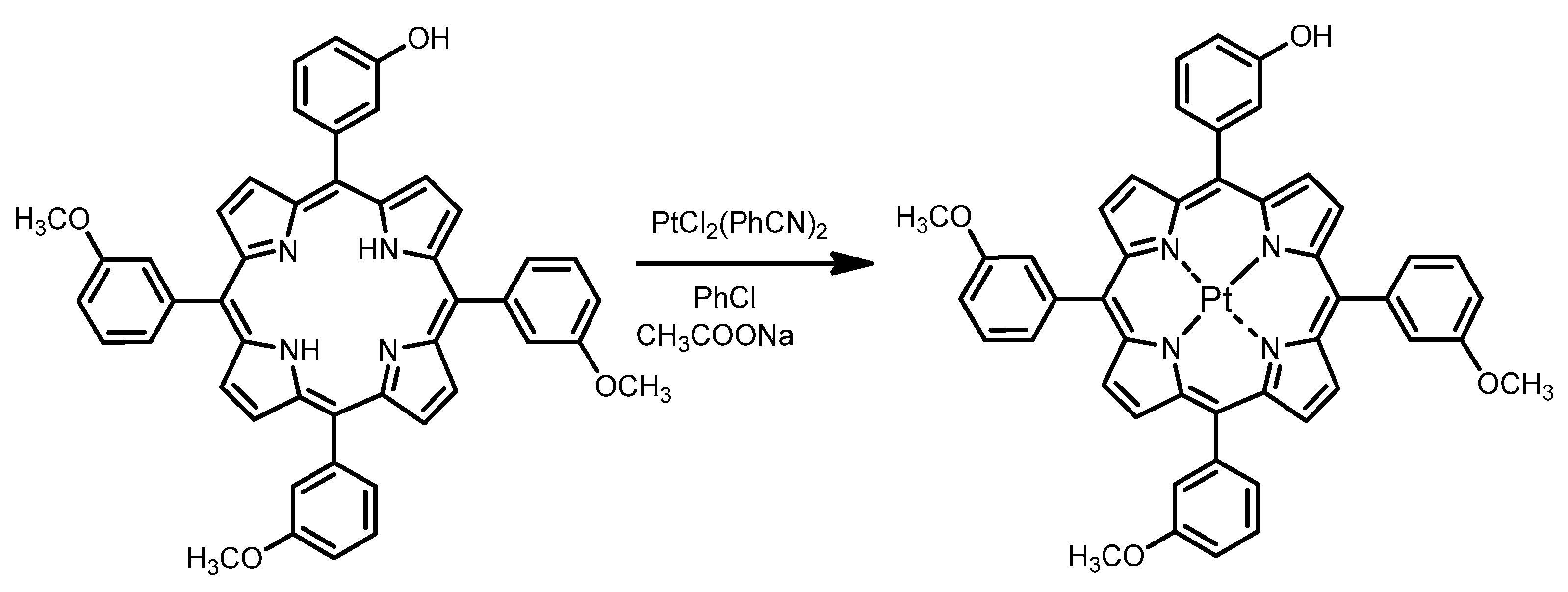

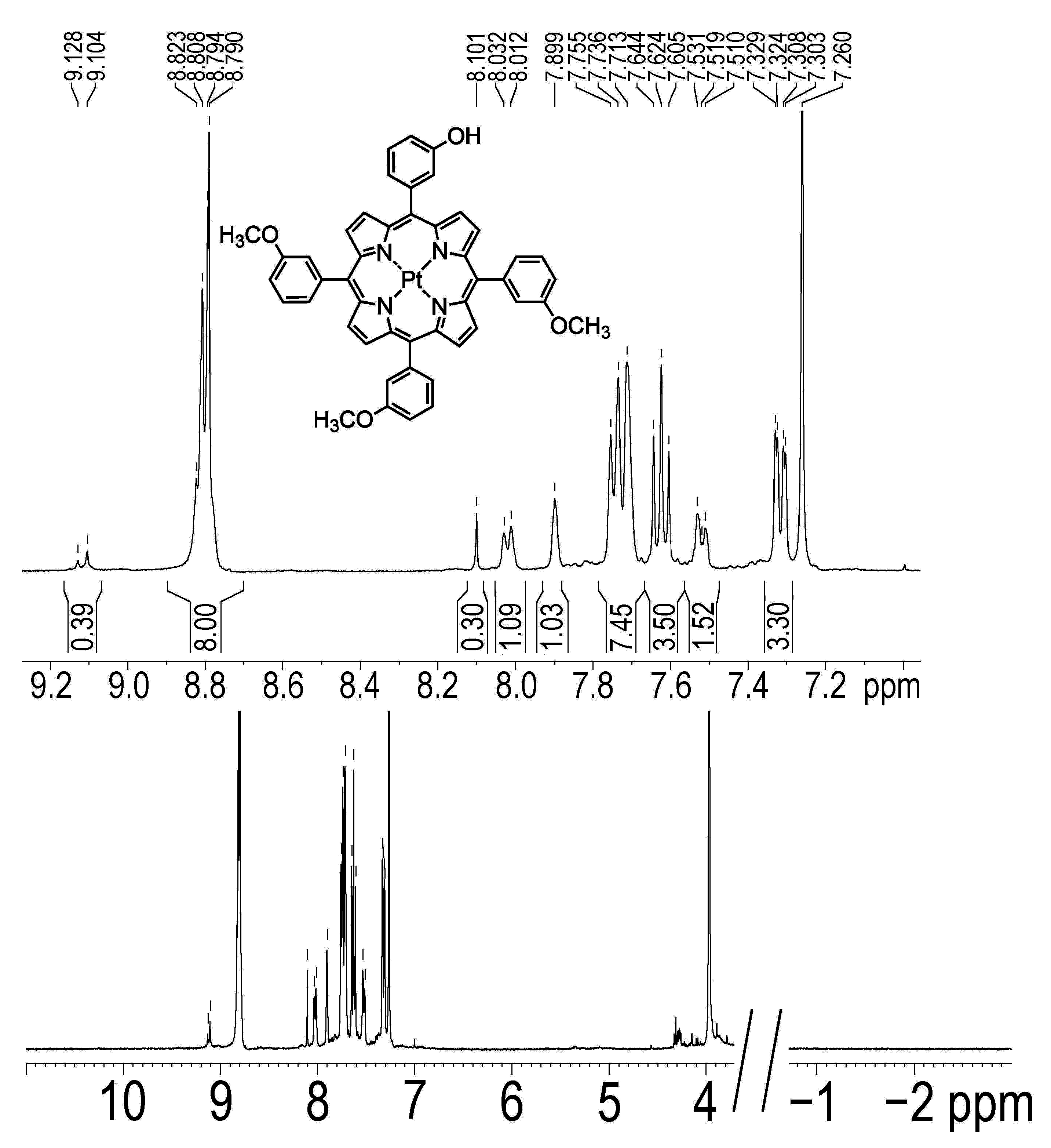
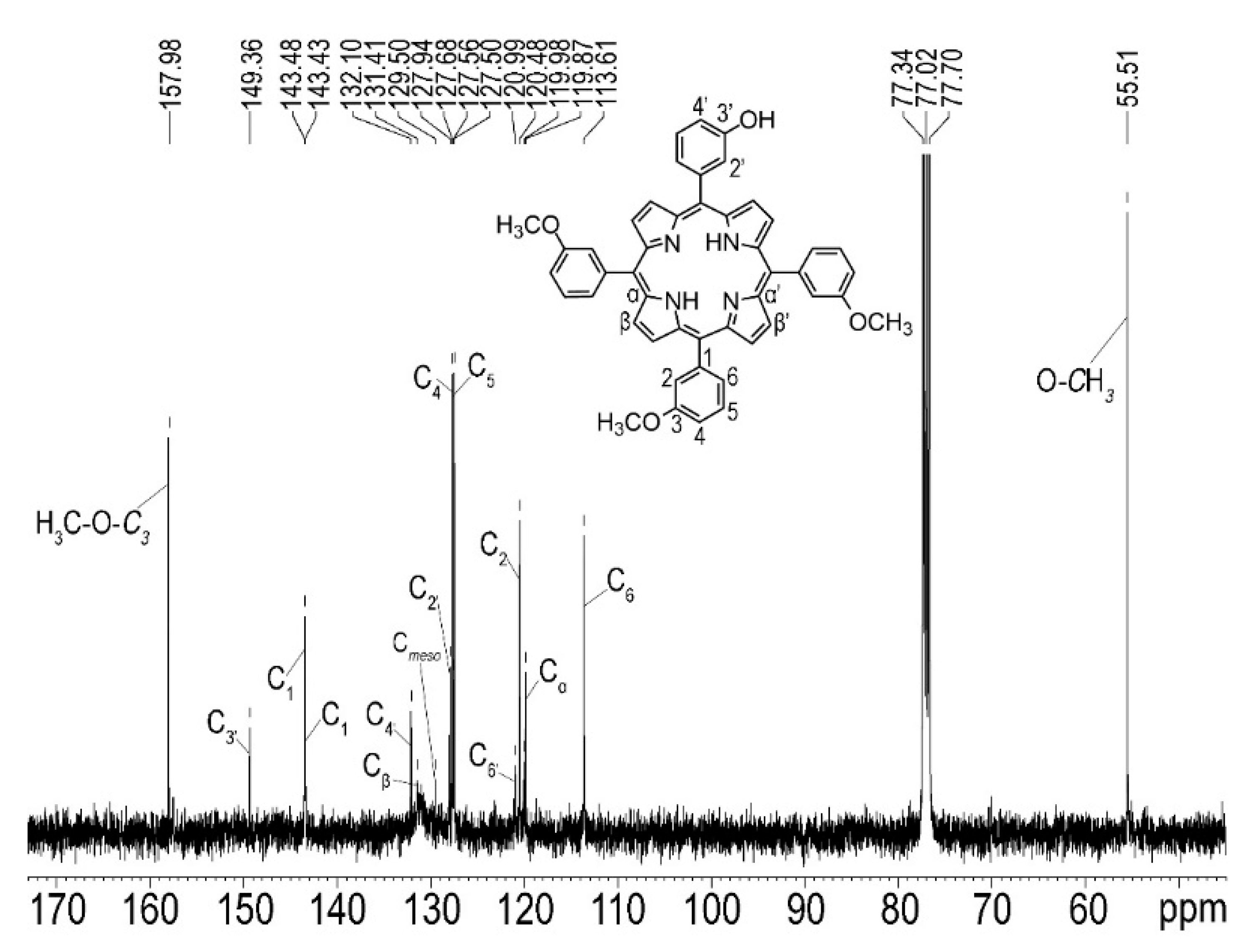

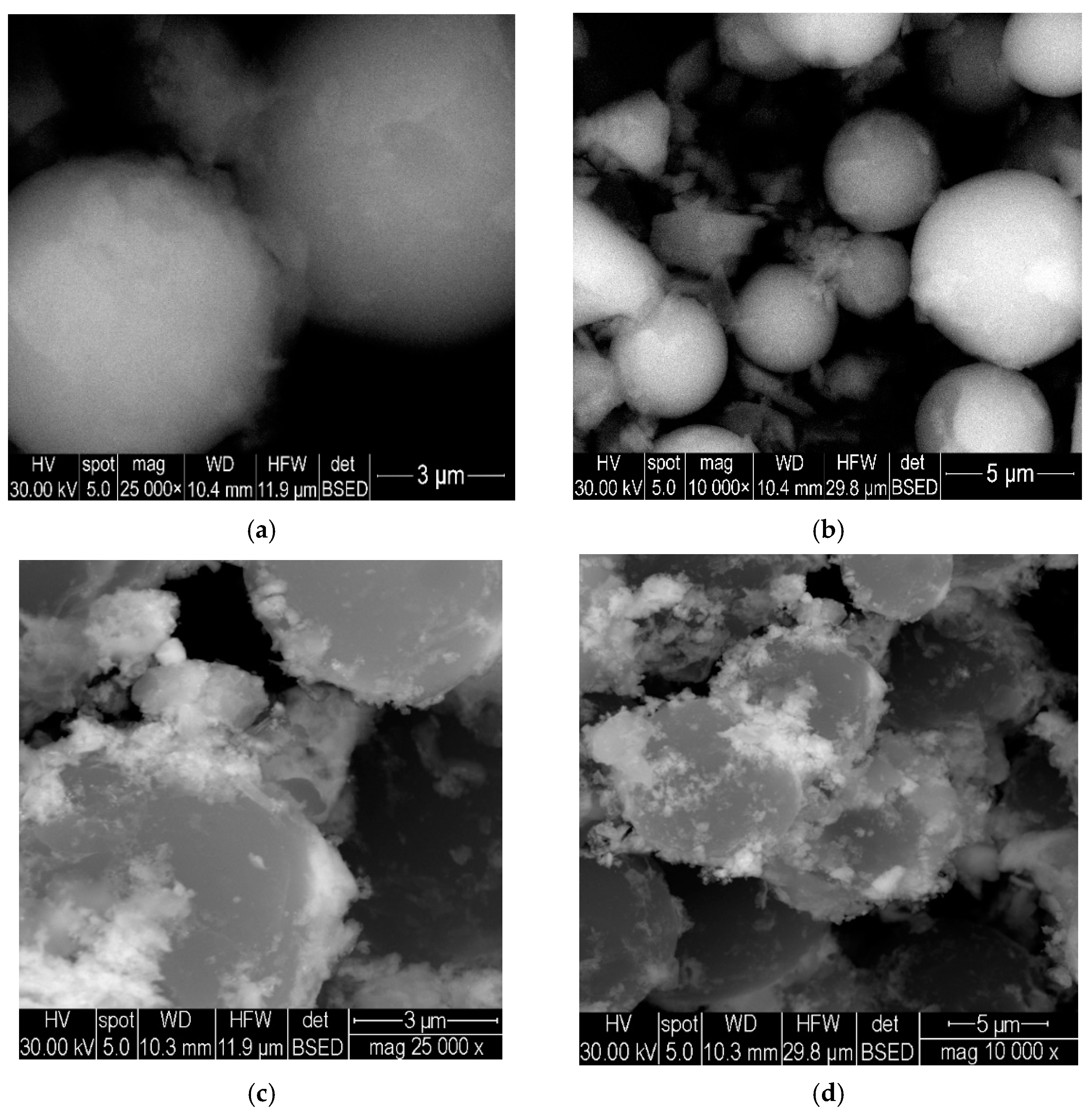





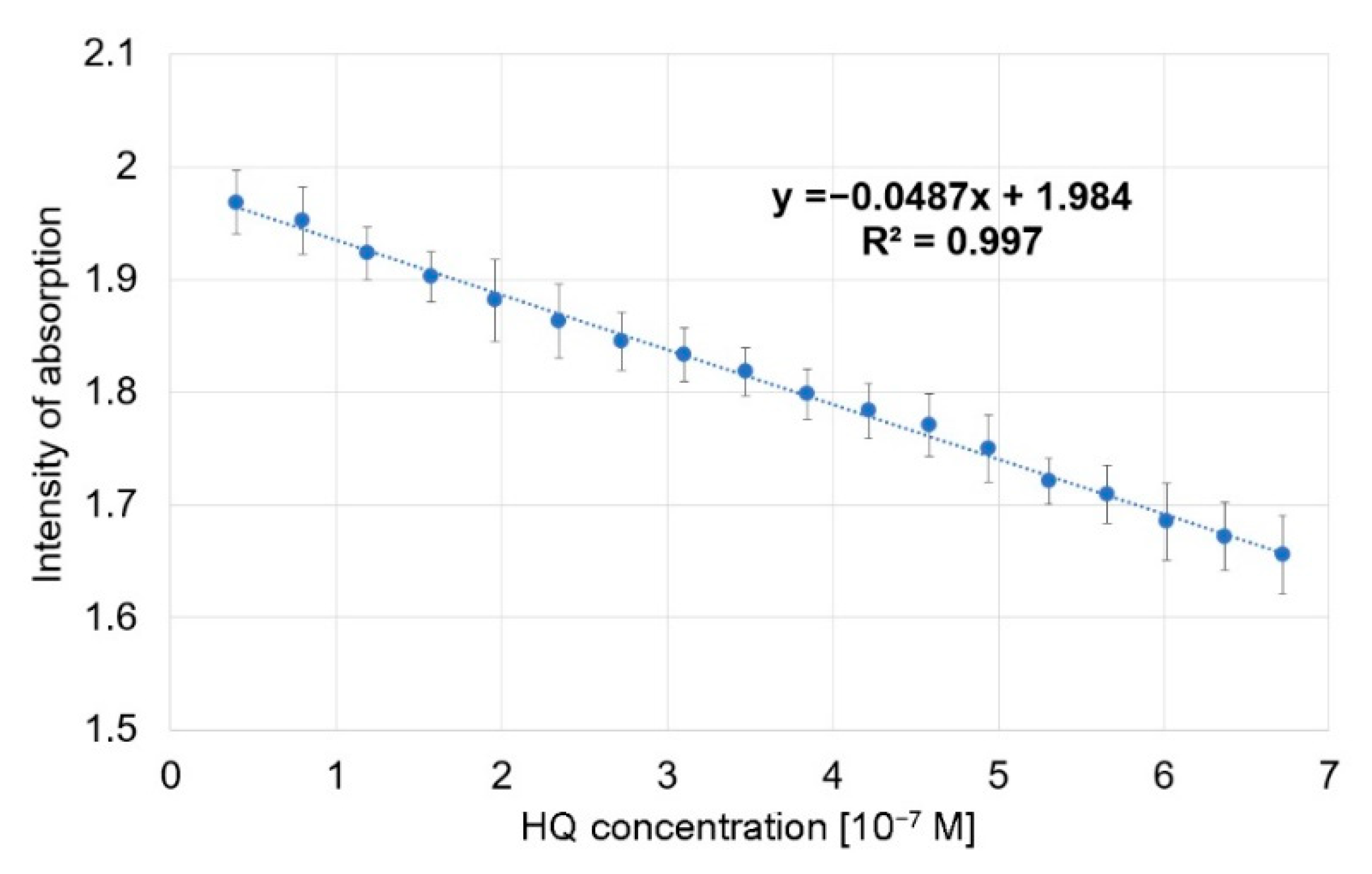
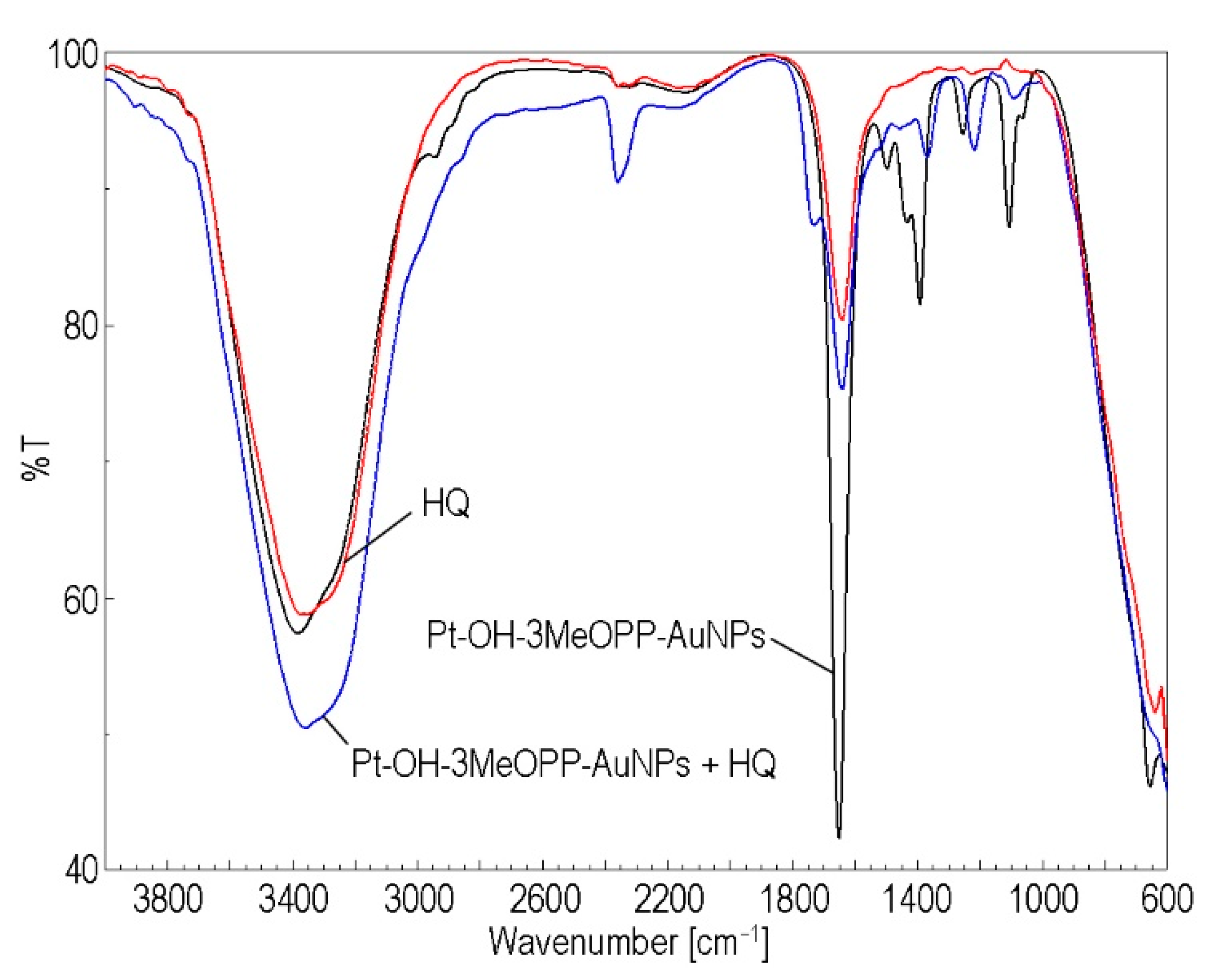
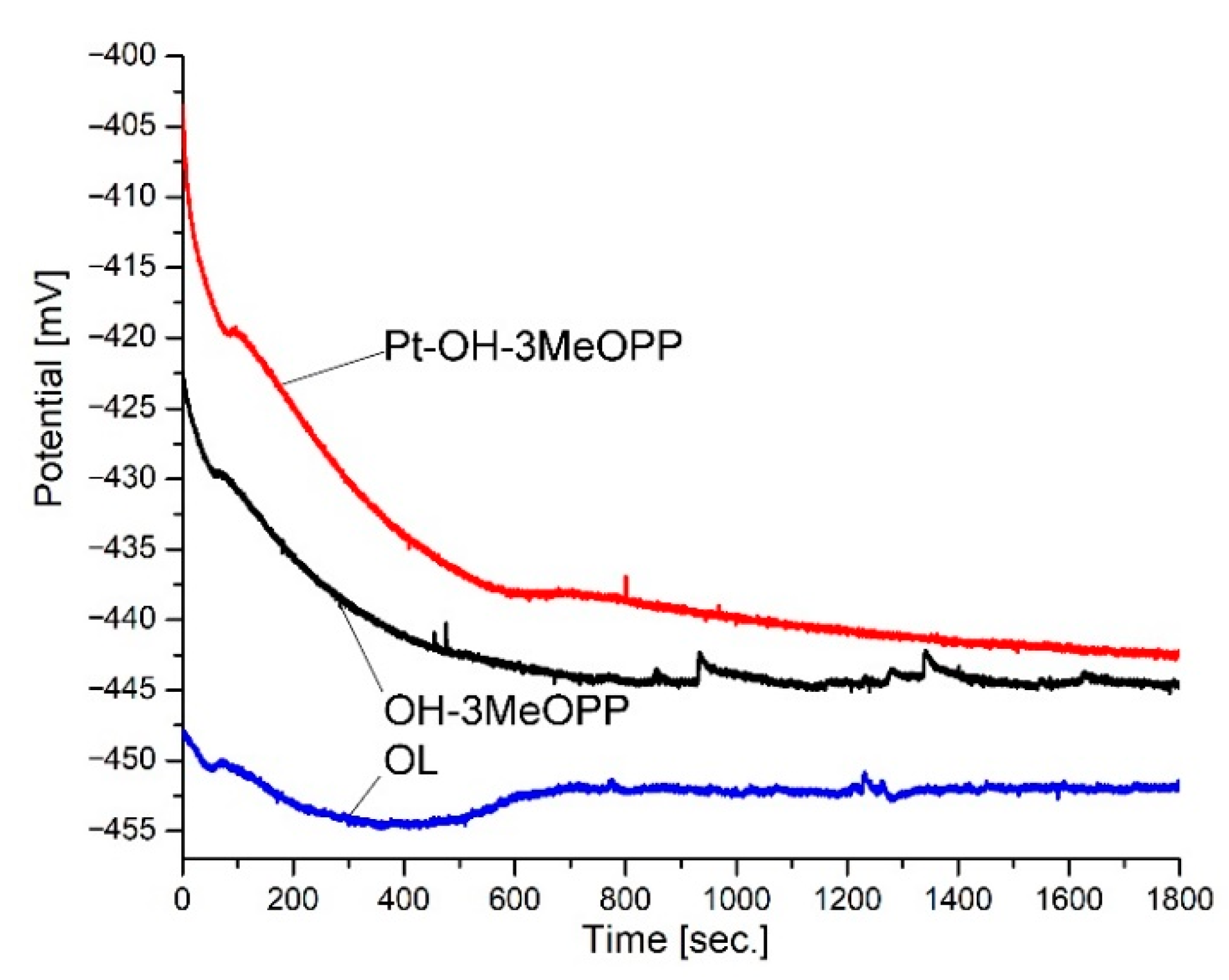
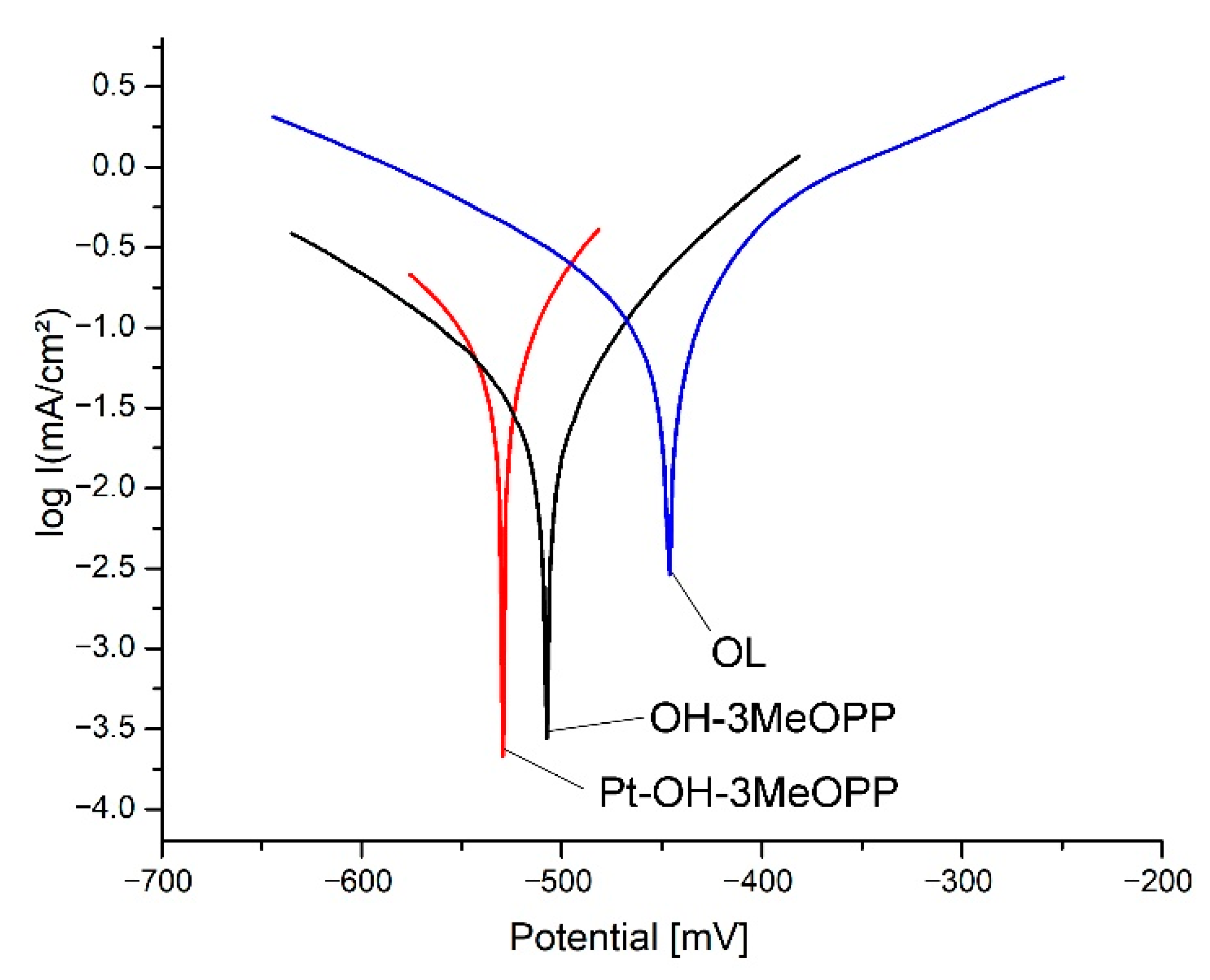
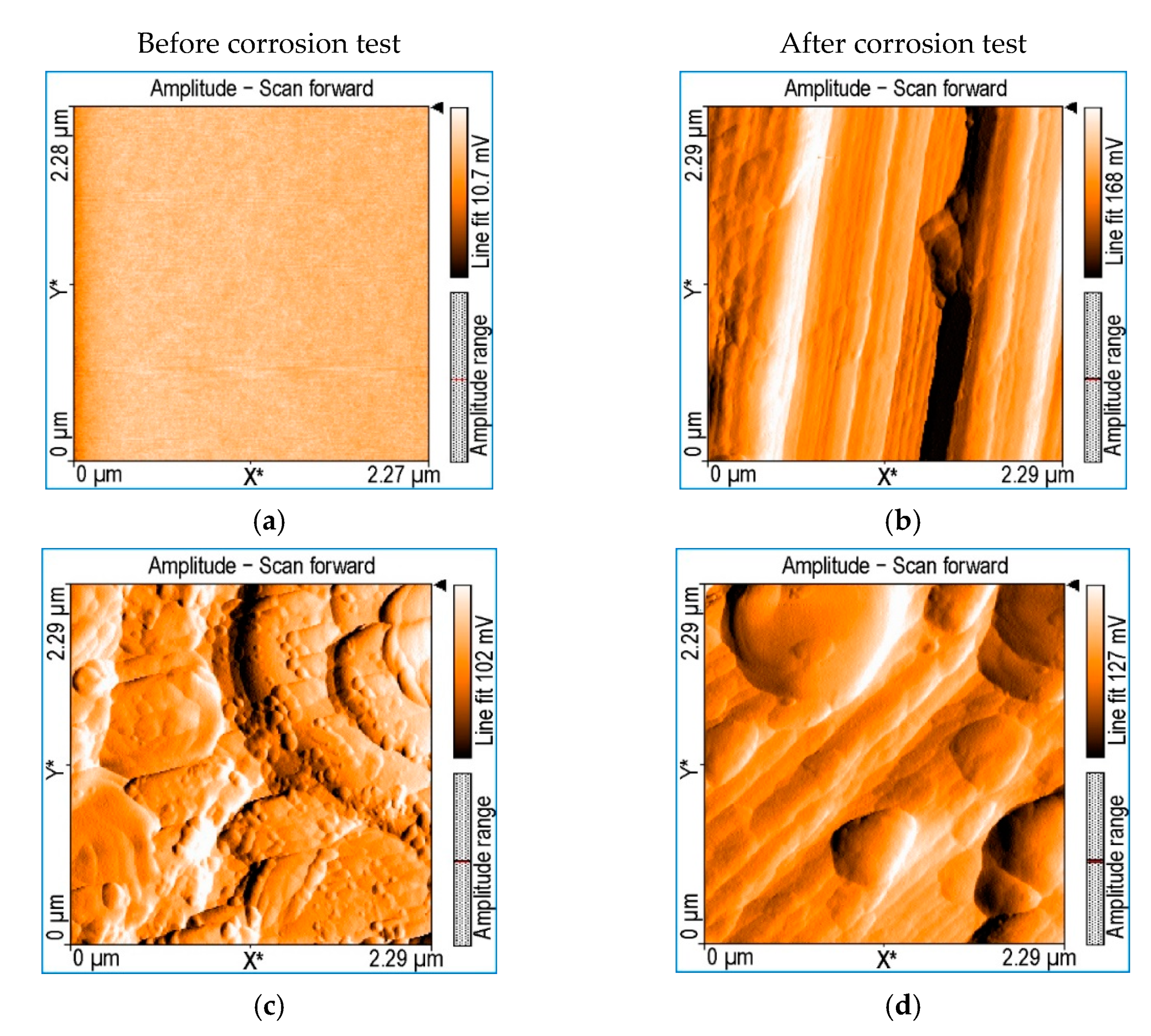
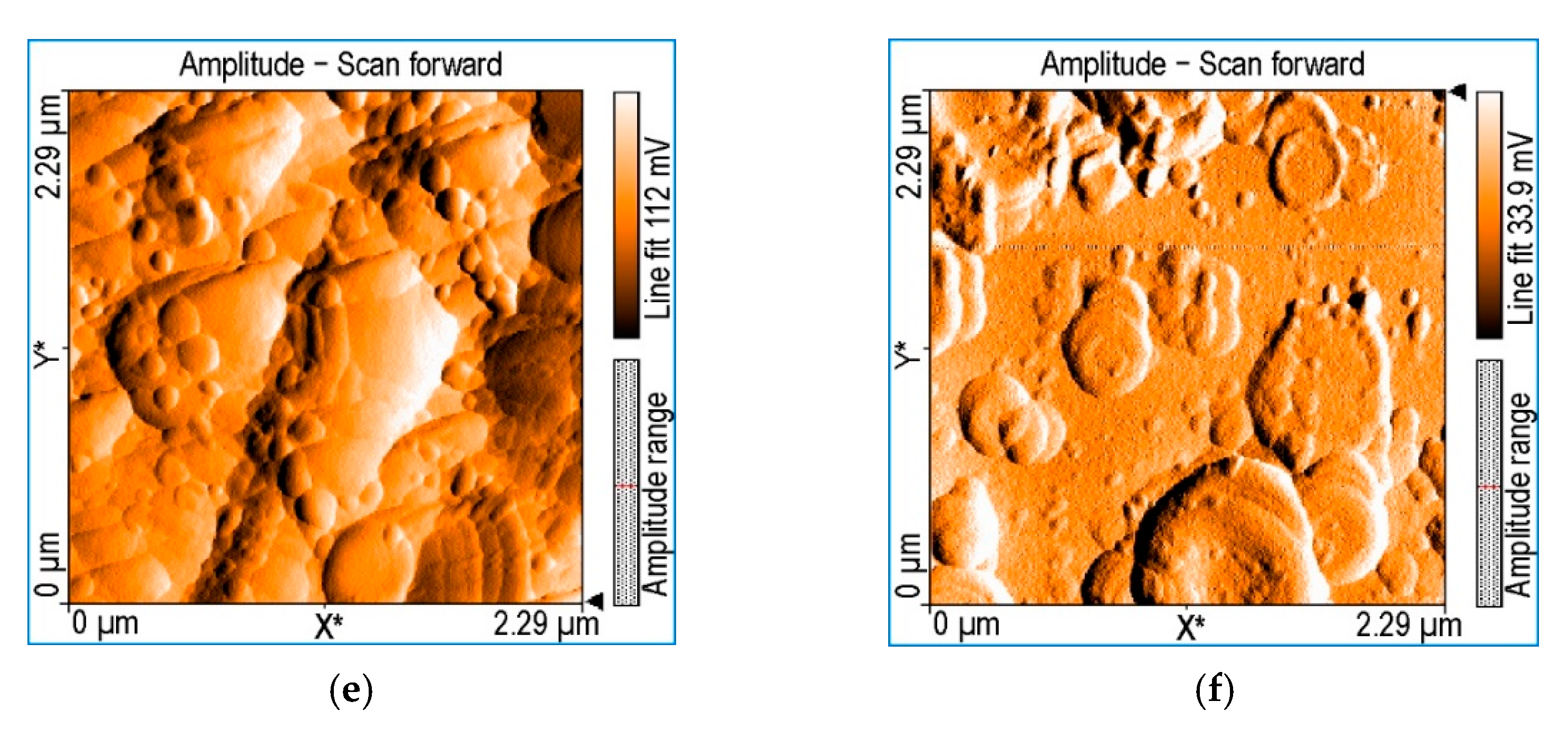

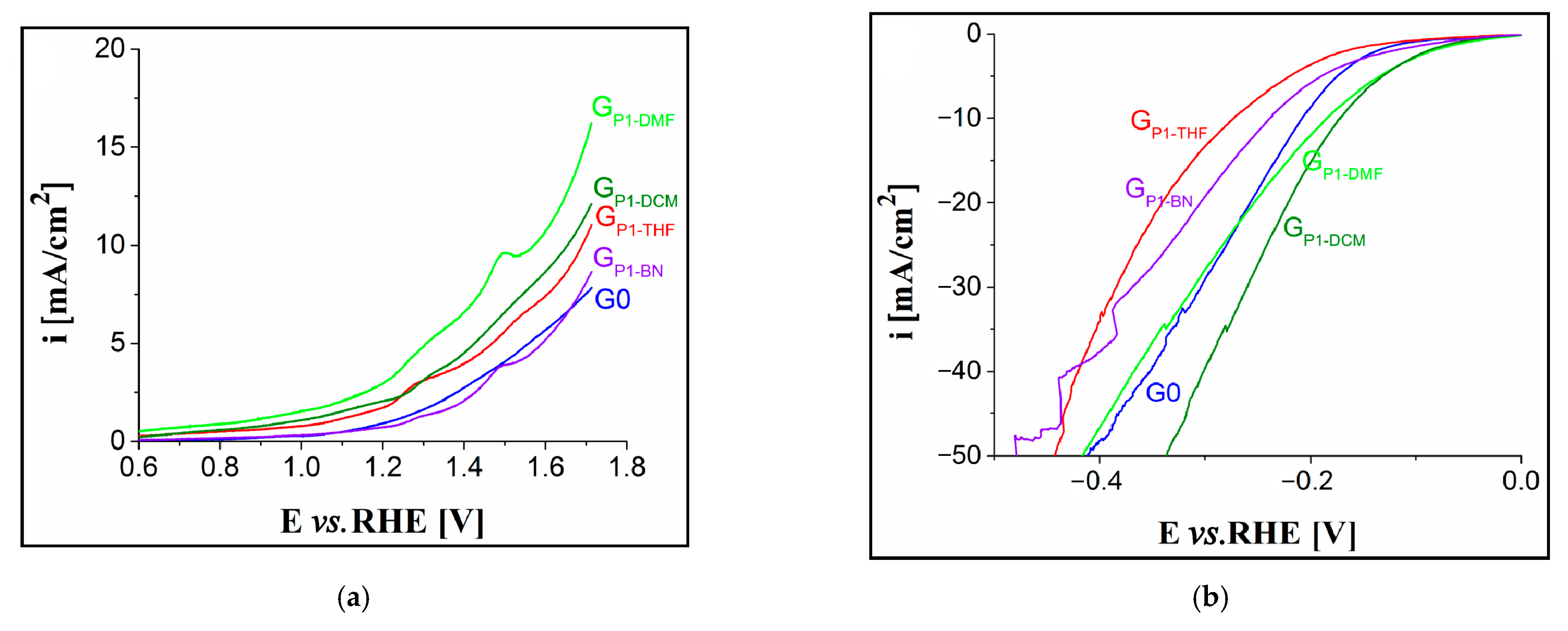
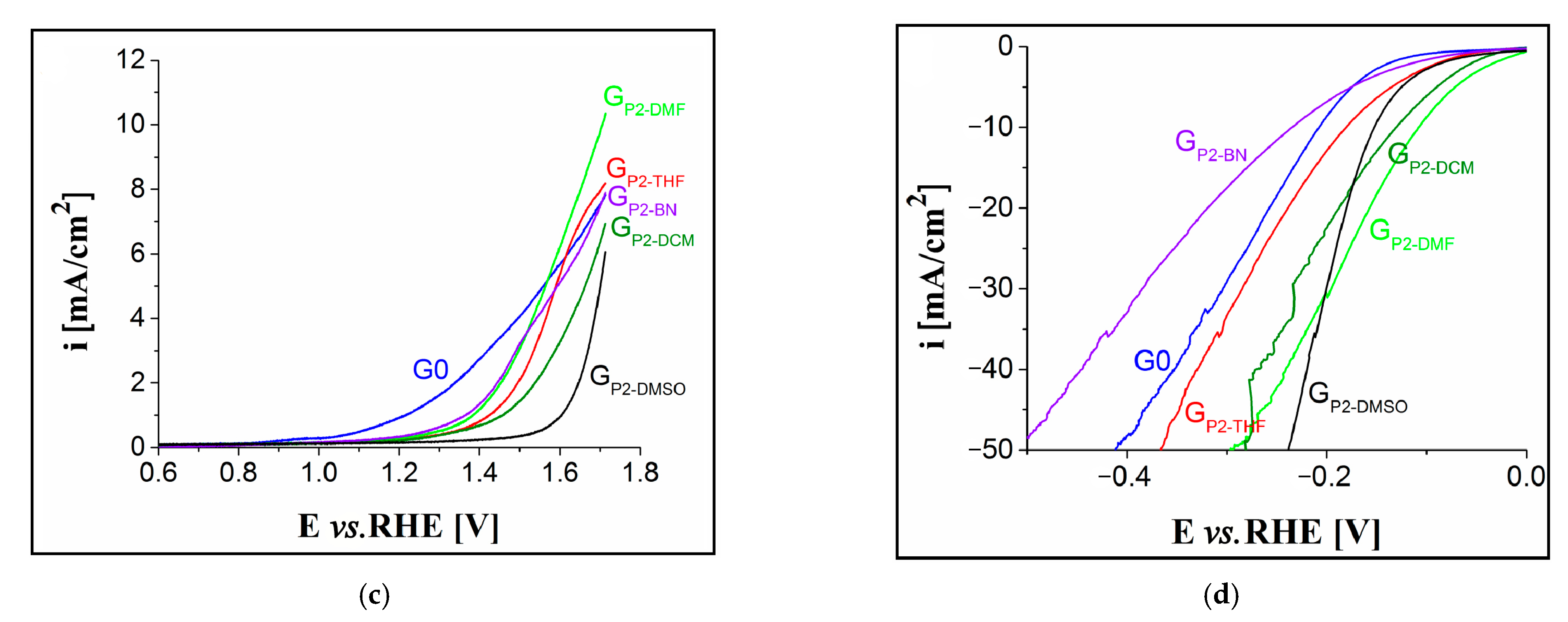
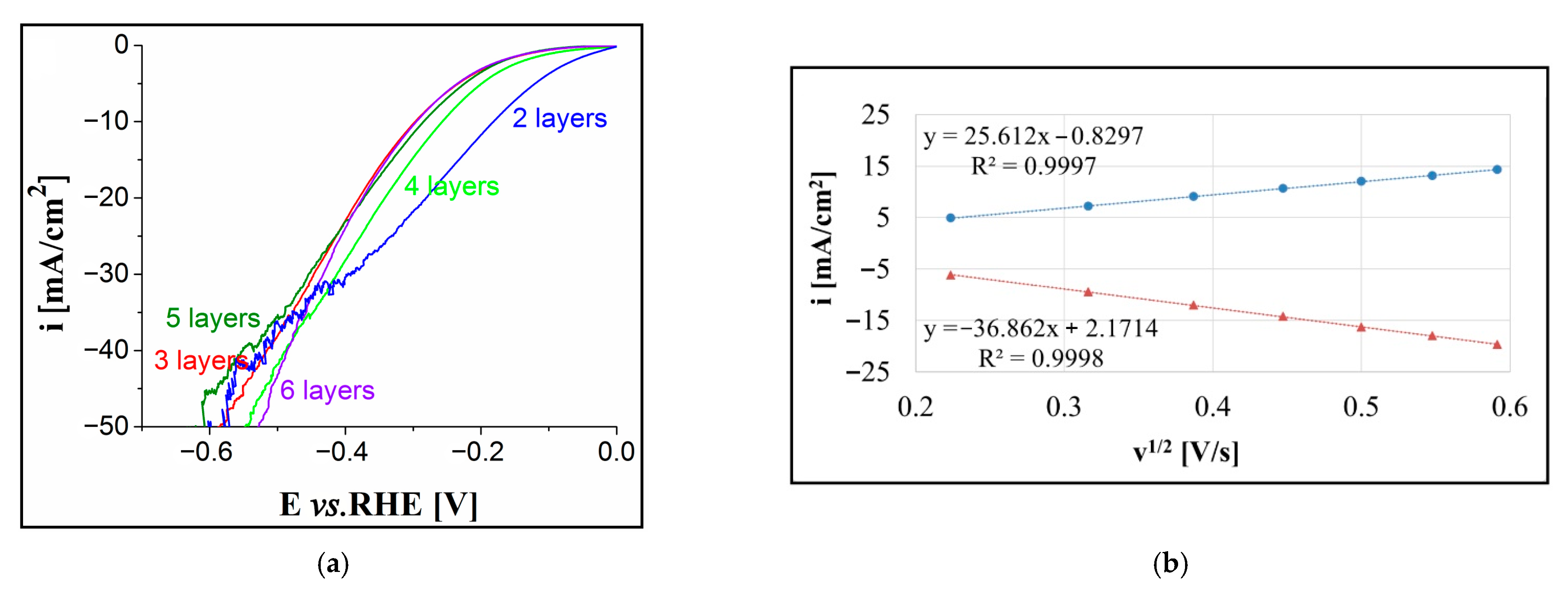
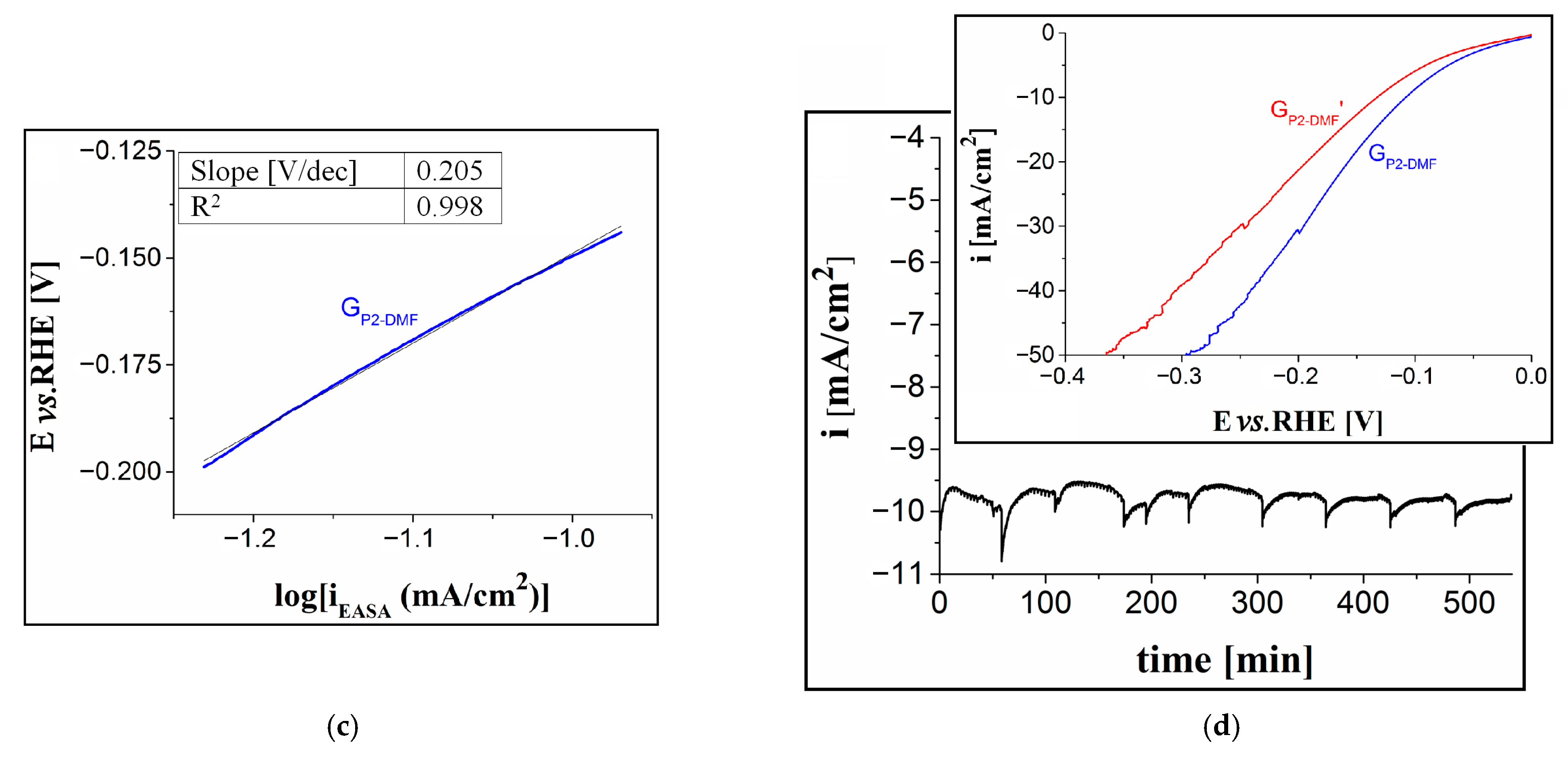
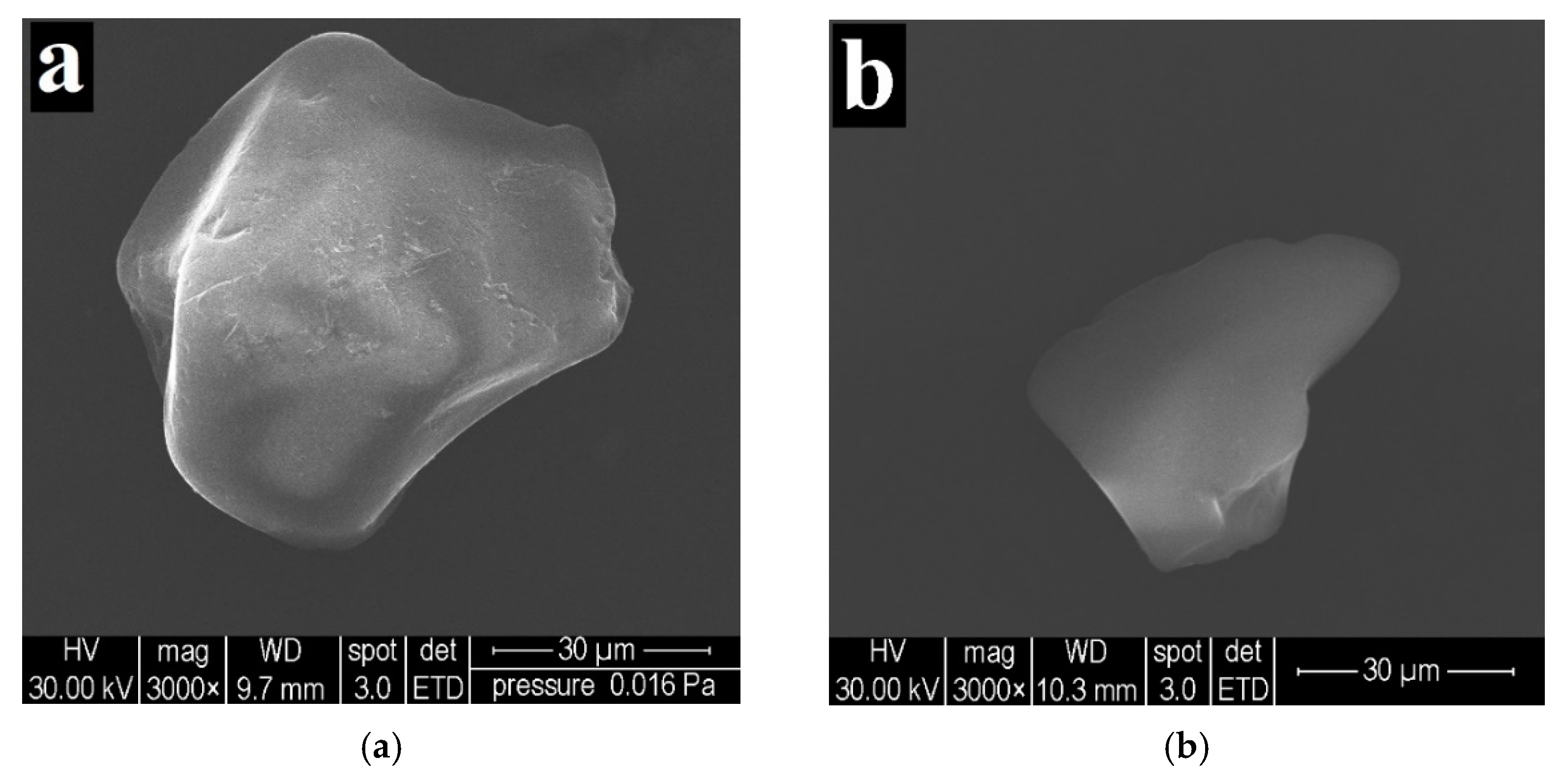
| Electrode Label | Porphyrin | Solvent |
|---|---|---|
| G0 | - | - |
| GP1-DMF | OH-3MeOPP | DMF |
| GP1-BN | OH-3MeOPP | BN |
| GP1-THF | OH-3MeOPP | THF |
| GP1-DCM | OH-3MeOPP | DCM |
| GP2-DMSO | Pt-OH-3MeOPP | DMSO |
| GP2-DMF | Pt-OH-3MeOPP | DMF |
| GP2-BN | Pt-OH-3MeOPP | BN |
| GP2-THF | Pt-OH-3MeOPP | THF |
| GP2-DCM | Pt-OH-3MeOPP | DCM |
| Interfering Analytes | Average Percentage Error |∆I/I| × 100 [%] |
|---|---|
| Ref = HQ | 0 |
| AA | 0.04296 |
| Urea | 0.15035 |
| DL-menthol | 0.20724 |
| CaGlu | 0.27981 |
| LA | 0.35701 |
| Glu | 0.56774 |
| KCl | 0.63914 |
| SA | 0.80343 |
| CaL | 1.36652 |
| FeCl3 | 2.23903 |
| SS | 2.29244 |
| NaCl | 3.38264 |
| KI | 16.5643 |
| Electrode | E (I = 0) (mV) | Rp (Ω cm2) | icorr (mA/cm2) | βa (mV) | βc (mV) | νcorr (mm/Y) | IE (%) |
|---|---|---|---|---|---|---|---|
| OL | −446.67 | 168.55 | 0.1922 | 149.6 | −191.7 | 2.24 | - |
| OH-3MeOPP | −508.23 | 245.10 | 0.0430 | - | −131.9 | 0.50 | 77.63 |
| Pt-OH-3MeOPP | −528.40 | 546.58 | 0.0230 | 29.7 | −48.3 | 0.26 | 88.03 |
| Sample | Area (pm2) | Sa before/after (nm) | Sq before/after (nm) | Particles Dimension before/after (nm) |
|---|---|---|---|---|
| OL | 5.305 | 0.21/40.31 | 0.32/44.03 | - |
| OH-3MeOPP | 16.53/27.26 | 22.49/35.43 | 76.1/97.5 | |
| Pt-OH-3MeOPP | 2.73/8.46 | 3.74/11.25 | 18.6/25.8 |
| Method of Detection | Sensitive Material | Limit of Detection [μM] | Detection Range [μM] | Advantages | Disadvantages | Ref. |
|---|---|---|---|---|---|---|
| Electro- chemical | active pencil lead covered with β -cyclodextrin and tera-kis(4-carboxyphenyl) porphyrin ligands with zirconium | 0.07 | 1−750 | - wide detection range - stability - selectivity | - tested only in natural water | [32] |
| poly (N-vinylcapro- lactam); rGO@Au; monoclinic bismuth metavanadate | 0.6 | 2.0−30.0 and 30.0−152.0 | - bio- compatibility - chemical stability | - temperature sensitive - high LOD | [97] | |
| acetylene black and gold nanoparticle composite modified glassy carbon electrodes | 1 | 2–500 | - selectivity - fast response | - tested only for tap water - high LOD | [98] | |
| carbon screen-printed electrodes pre-treated in 0.5 mol/L sulphuric acid solution | 0.218 | 0.5−10.0 | - simple - low cost | - few interference species studied | [99] | |
| carboxylic acid-functionalised graphene-modified glassy carbon electrode | 0.04 | 0.1–40.0 | - accuracy - fast response - selectivity | - | [100] | |
| direct green 6 decorated carbon paste electrode | 0.11 | 10–45 | - stability - adapted for tap water testing | - narrow detection range, - only few interferences studied | [101] | |
| glassy carbon electrode modified with cobalt oxide nanorod | 0.2 | 5–200 | - large detection range | - no organic compounds present in body fluids studied as interference species | [102] | |
| Electro- catalytic | covalent organic framework based on 5,10,15,20-tetrakis-(4-amino-phenyl)-porphyrin | 0.009 | 0.1−100 | - good biocompatibility - high sensitivity and stability | - interference species with low concentrations were tested | [33] |
| Photo– electrochemical | 5-[p-(3-Mercapto- propyl-oxy)-phenyl]-10,15,20- triphenyl–porphyrin/AuNPs/graphene | 0.0046 | 0.020−0.24 | - sensitivity - stability - low LOD | - no organic compounds present in body fluids studied as interference species | [30] |
| UV-Vis detection | acidulated Pt-OH-3MeOPP-AuNPs complex | 0.013 | 0.039–6.71 | - highly selective - fast response - low LOD -suitable for medical testing including diabetes patients | - narrow detection range | This work |
| Fluorescence | OH-3MeOPP in acid medium | 0.022 | 0.065–6.35 | -highly selective -fast and simple method -high accuracy for testing thyroid illness patients | -narrow detection range | This work |
Publisher’s Note: MDPI stays neutral with regard to jurisdictional claims in published maps and institutional affiliations. |
© 2022 by the authors. Licensee MDPI, Basel, Switzerland. This article is an open access article distributed under the terms and conditions of the Creative Commons Attribution (CC BY) license (https://creativecommons.org/licenses/by/4.0/).
Share and Cite
Fratilescu, I.; Lascu, A.; Taranu, B.O.; Epuran, C.; Birdeanu, M.; Macsim, A.-M.; Tanasa, E.; Vasile, E.; Fagadar-Cosma, E. One A3B Porphyrin Structure—Three Successful Applications. Nanomaterials 2022, 12, 1930. https://doi.org/10.3390/nano12111930
Fratilescu I, Lascu A, Taranu BO, Epuran C, Birdeanu M, Macsim A-M, Tanasa E, Vasile E, Fagadar-Cosma E. One A3B Porphyrin Structure—Three Successful Applications. Nanomaterials. 2022; 12(11):1930. https://doi.org/10.3390/nano12111930
Chicago/Turabian StyleFratilescu, Ion, Anca Lascu, Bogdan Ovidiu Taranu, Camelia Epuran, Mihaela Birdeanu, Ana-Maria Macsim, Eugenia Tanasa, Eugeniu Vasile, and Eugenia Fagadar-Cosma. 2022. "One A3B Porphyrin Structure—Three Successful Applications" Nanomaterials 12, no. 11: 1930. https://doi.org/10.3390/nano12111930
APA StyleFratilescu, I., Lascu, A., Taranu, B. O., Epuran, C., Birdeanu, M., Macsim, A.-M., Tanasa, E., Vasile, E., & Fagadar-Cosma, E. (2022). One A3B Porphyrin Structure—Three Successful Applications. Nanomaterials, 12(11), 1930. https://doi.org/10.3390/nano12111930






